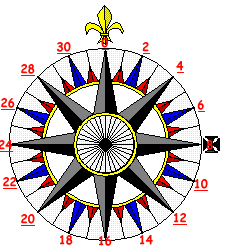







The Voyage of the Alamar
 Compass Rose
Compass Rose
The 32 Points of the Compass
| Point 0 1 2 3 4 5 6 7 8 9 10 |
Direction North N by E NNE NE by N NE NE by E ENE E by N East E by S ESE |
Azimuth 0° - 0' 11° - 15' 22° - 30' 33° - 45' 45° - 0' 56° - 15' 67° - 30' 78° - 45' 90° - 0' 101° - 15' 112° - 30' |
Point |
Direction SE by E SE SE by S SSE S by E South S by W SSW SW by S SW SW by W |
Azimuth
123° - 45' 135° - 0' 146° - 15' 157° - 30' 168° - 45' 180° - 0' 191° - 15' 202° - 30' 213° - 45' 225° - 0' 236° - 15' |
Point 22 23 24 25 26 27 28 29 30 31 |
Direction |
Azimuth |
Origins of the Compass Rose
by Bill Thoen
The compass rose has appeared on charts and maps since the 1300's when
the
portolan charts first made their appearance. The term "rose"
comes from
the figure's compass points resembling the petals of the well-known flower.
Originally, this device was used to indicate the directions of the winds
(and it was then known as a wind rose), but the 32 points of the compass
rose
come from the directions of the eight major winds, the eight half-winds
and
the sixteen quarter-winds.
In the Middle Ages, the names of the winds were commonly known
throughout the Mediterranean countries as tramontana (N), greco
(NE), levante (E), siroco (SE), ostro (S), libeccio (SW),
ponente (W) and maestro (NW). On portolan charts you can see the
initials of these winds labeled around the edge as T, G, L, S, O,
L, P, and M.
The 32 points are therefore simple bisections of the directions
of the four winds (but the Chinese divided the compass into 12
major directions based on the signs of the Zodiac). For western
apprentice seamen, one of the first things they had to know were
the names of the points. Naming them all off perfectly was
known as "boxing the compass".
There is no absolute standard for drafting a compass rose, and each
school of cartographers seems to have developed their own. In the
earliest charts, north is indicated by a spearhead above the letter
T (for tramontana). This symbol evolved into a fleur-de-lys around
the time of Columbus, and was first seen on Portuguese maps. Also
in the 14th century, the L (for levante) on the east side of the
rose was replaced with a cross, indicating the direction to
Paradise (long thought to be in the east), or at least to where
Christ was born (in the Levant).
The colors on the figure are supposedly the result of the need
for graphic clarity rather than a mere cartographical whim. On a
rolling ship at night by the light of a flickering lamp, these
figures had to be clearly visible. Therefore the eight principle
points of the compass are usually shown on the compass rose in black
which stands out easily. Against this background, the points
representing the half-winds are typically colored in blue or green
and since the quarter-wind points are the smallest, they are usually
colored red.